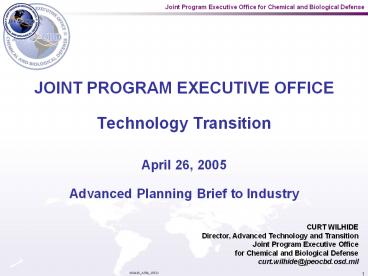JOINT PROGRAM EXECUTIVE OFFICE Technology Transition - PowerPoint PPT Presentation
Title:
JOINT PROGRAM EXECUTIVE OFFICE Technology Transition
Description:
JOINT PROGRAM EXECUTIVE OFFICE Technology Transition April 26, 2005 Advanced Planning Brief to Industry CURT WILHIDE Director, Advanced Technology and Transition – PowerPoint PPT presentation
Number of Views:127
Avg rating:3.0/5.0
Title: JOINT PROGRAM EXECUTIVE OFFICE Technology Transition
1
JOINT PROGRAM EXECUTIVE OFFICETechnology
Transition
- April 26, 2005Advanced Planning Brief to
Industry
CURT WILHIDE Director, Advanced Technology and
Transition Joint Program Executive Office for
Chemical and Biological Defense curt.wilhide_at_jpeoc
bd.osd.mil
2
Vision
- Develop and Sustain a Comprehensive, Agile, and
Flexible Transition Program that - Responds to DoD CBDP Capability Needs
- Provides Multiple Program, Agency, Vendor Access
- Facilitates Multiple Acquisition/ Procurement
Opportunities - Maximizes Opportunity for Best Capability at the
appropriate maturity - Manages Technology Transition
3
Accelerating Technology Transition Operation
Iraqi Freedom
New Capabilities
4
Integrated Technology Transition Overview
5
Transition Drivers
- Programs Starting at MS B Need
- Technology Development Strategy
- Test and Evaluation Strategy
- Program Alignment
- Technology Transition Agreement
- Exit Criteria for Proposed Program of Record
- Rational POM Build
- ST Strategy Needs to Include
- Traceability to Metrics and Requirements
- Basis For Trade-offs in the Development Process
6
Where Does My Technology Fit? Technology
Readiness Levels
Program Development Phase
Basic/Applied Research
Advanced Technology Development
Advanced Component Development
System Development and Demonstration
Production and Operational System Development
1-2-3-4
5-6
6-7
7-8
8-9
TRLs
1 Basic Principles Observed 2 Technology
Concept Formulated 3 Proof of Concept 4
Laboratory Environment Component/Breadboard
Demo 5 Relevant Environment Component/Breadboard
Demo
6 Prototype Demo in Relevant Environment 7
Prototype Demo in Operational Environment 8
System Qualified through Test and Demo 9 System
Proven in Operational Conditions
Joint Science and Technology Office DARPA
Joint CBDP Program Executive Office Joint CBDP
Project Managers
http//www.dodsbir.net http//www.dtra.mil http
www.darpa.mil/
http//www.jpeocbd.osd.mil http//www.fedbizopps.g
ov
7
Technology Transition Agreement (TTA)
- Required for All ST Programs for Transition to
Advanced Development - Identifies Target Program of Record
- Programs With No TTA May Not Be Funded
- Primary Vehicle for Transition of Technologies to
the Program - Functions as the Technology Development Strategy
- Contains Information Necessary to Conduct
Technology Readiness Assessment (TRA) - Exit Criteria (to Include TRLs)
- Test and Evaluation Strategy
- Receiver Operator Characteristic (ROC) Curve
Metrics and Attributes - Acts as the Agreement Between the Advanced
Developer and the ST Community for Successful
Transition
8
ROC Curve
- Historically, Technologies Transition Without
Metrics and Attributes that Allow Joint Project
Manager (JPM) to Conduct Trade-Off Analyses - ROC Curves and Spider Charts are Tools to
Characterize Performance
9
Spider Chart
- Assess Technology Attributes
- Basis for Trades
10
Alignment Methodology
11
Technology Readiness Assessment (TRA)
- Review of Specific Component or System Determined
to Have Met Criteria in the TTA - Conducted Prior to Transition to Advanced
Development - All Critical Technologies Assessed
- Joint Project Manager (JPM) Defines the
Attributes/ Criteria for Each TRL Level - Joint Science and Technology Office Conducts the
TRE - JPM Assigns the TRL Based on the Independent TRE
Results - Overall System TRL Determined by Lowest TRL of
Components and/or Subcomponents
12
Technology Readiness Assessments (TRA) Process
13
Technology Readiness Evaluation
- Provides Data to Support Technology Readiness
Assessment (TRA) - Paper Studies
- Field Test
- Lab Tests
- Used to Determine Effectiveness and Suitability
of a Technology to Meet Program Criteria - Conducted Prior to a Transition Event to Support
a Milestone Decision, P3I, or Transition to
Advanced Development - Joint Science and Technology Office Executes the
TRE
14
Upcoming Technology Readiness Assessments
- FY05 Collective Protection Technologies
- Absorbent Technologies
- Next Generation Filtration
- Tent and Liner Materials
- CP Systems
- Seals and Air Locks
- FY06 Next Generation Standoff Chemical and
Biological Detection Systems - Active and Passive
- Sub Systems
- Integrated Platforms
- FY07 Information System Tools
- Comparison of New Modeling and Simulation Tools
to Real World - Sensor Integration Testing
15
Transition Quarterly Review
- Organizations Represented
- JPEO-CBD
- Joint Science and Technology Office
- Joint Test and Evaluation Executive
- Joint Requirements Office
- Monitors Progress of Technology Transition
- Identify Candidate ST Technology Areas/Programs
for Future Transition - Review Transition Testing Programs and Plans for
Tests and Test Methodology Development - Report on Transition Tests and Results
- Develop Future Year Program Transition
Requirements - Review Status and Currency of TTAs
16
Technology Transition Opportunities
- ST Broad Area Announcements/ TRAs
- JPM Sponsored Announcement
- Operational Needs Statement/ Urgent Needs
Statement - Future Hot Button Issues
- Biological Detection/ Identification
- Stand-off
- Fast, ACCURATE, Low Cost, Low Consumables
- Medical Surveillance
- Decontamination
- Broad Spectrum
- Improved Logistics
- Broad Compatibility
- Network Centric
- Surveillance
- Cueing/ Detection/ Identification
- Data Fusion
17
Resources Available
- Technology Readiness Assessment Deskbook
- Published by DUSD (ST)
- CBDP Technology Transition Handbook
18
Points of Contact
- Dr David Cullin, Technology Director
- 703.681.9607
- dave.cullin_at_jpeocbd.osd.mil
- Curt Wilhide, Director Advanced Technology and
Transition - 703.681.9607
- curt.wilhide_at_jpeocbd.osd.mil































